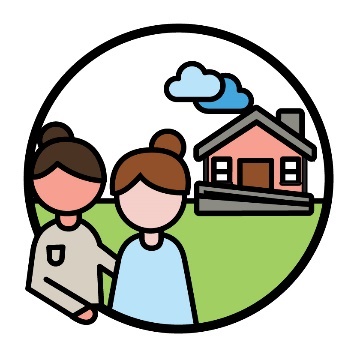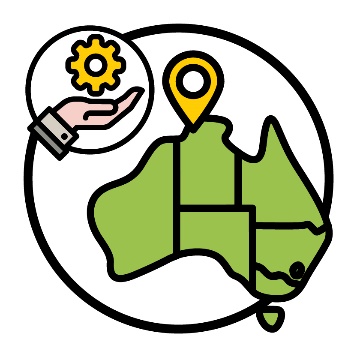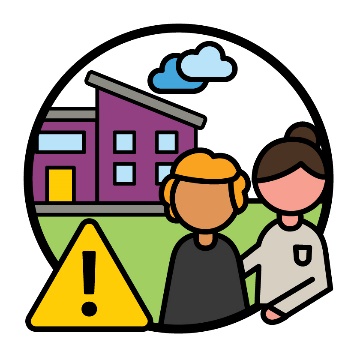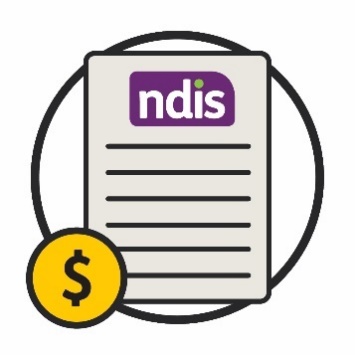What did our Council Members share?
| Our Council Members connect with the community to find out about issues that affect them. |
| Our Council Members shared these issues with the NDIA. |
How the NDIA works
| Council Members explained it’s important to keep supports that help people with disability be safe from COVID-19. | |
| They want these supports to keep coming from the:
| |
| Council Members shared that the community is happy Dr Richard Fejo joined the NDIA Board. | |
| Council Members explained there are issues with services in the Northern Territory. | |
This includes services from: | ||
|
| |
|
| |
| And includes issues with the skills of people who support people with disability, like support workers. | |
| The NDIA is working with the community to check the prices of NDIS supports. | |
| Council Members shared that people need more time to:
| |
| Council Members shared that the NDIA should look at the best way for providers to deliver supports in areas far away from:
| |
| Providers deliver services and supports to people with disability. | |
| People also want the NDIA to think about the best way to support workers. | |
| This includes how to support a worker’s cultural beliefs. For example, if something is important to them because of their background and way of life. | |
| And how to support workers when something in their life changes. | |
| This also includes how providers could hire family members to support participants. | |
| Council Members explained there was a meeting for CALD community leaders in February 2023. | |
| Members from these communities shared their experiences. | |
Providers
| Council Members explained that some providers don’t believe the NDIS Review is supporting them as it should. | |
| The Australian Government is checking the NDIS. We call this the NDIS Review. | |
The NDIS Review checks to see what: | ||
|
| |
|
| |
| Some providers are not sure that the NDIS Review can fix issues in some areas of Australia. For example, issues that affect the Northern Territory. | |
| And some providers worry about how they will afford to change things the Disability Royal Commission suggests. | |
| The Disability Royal Commission is a way to look into the experiences of people with disability. | |
| It’s already harder for some smaller providers to follow all the rules. | |
| This includes the rules from the NDIS Quality and Safeguards Commission (NDIS Commission). |
| The NDIS Commission makes sure people with disability who take part in the NDIS:
|
| And the NDIS Commission doesn’t work much with states and territories. |
NDIS supports
| Council Members worry that there isn’t enough information about Justice Liaison Officers (JLOs). |
| JLOs support prisons to understand how the NDIS can support people with disability in prisons. |
| Council Members explained that the NDIS doesn’t always support participants to get a prosthetic when they have a physical disability in their arm. |
| A prosthetic is equipment that replaces a part of your body, like your arm. |
Some people shared that the NDIA: | |
|
|
|
|
Council Members shared issues with services from: | |
|
|
|
|
| Council Members shared that the community is happy that participants are leaving hospital sooner. | |||
| But they also shared that some participants can’t use NDIS supports in hospital. | |||
| This includes participants who might need more supports. | |||
| Council Members shared that some providers tell families to make choices for participants. | |||
| But this stops them from taking part in decisions about their own lives. | |||
| Council Members explained that some participants can’t get the support technology they need. | |||
| Some people who manage plans tell participants that the NDIA will say no to technology. So they don’t apply for technology that participants need. | |||
| Council Members explained that there is a podcast about the NDIS. And there is a good episode about managing your own plan. | |||
| The podcast is Reasonable and Necessary: Making Sense of the NDIS. | |||
NDIS plans
| Council Members explained that people worry about the type of support LACs deliver. They worry it doesn’t work well. |
| Council Members shared that it needs to be easier for participants to ask to check a decision the NDIA made about their plan. This is important for participants who need support for their behaviour. |
| Council Members shared that some plans have lots of rules about what supports participants can spend money on. |
| This can make it harder for participants to use their plan. |
Home and living
| Council Members shared there are issues with supported independent living (SIL) for First Nations peoples in the Northern Territory. |
| SIL is help with day-to-day tasks around your home so you can:
|
| Some First Nations peoples had to move to Darwin to find and use:
|
| Council Members explained that some participants have issues with funding for support at home. |
| Funding is money from your plan that pays for the supports and services you need. |
| Most funding is for one support worker for 3 participants. But this is a problem for participants who need more support. |
| Council Members shared that participants are losing some of their SIL supports in their plans. |
| This has been causing stress for:
|
| Council Members explained that the NDIA should:
|
Working with other services
| Council Members shared that people want to know how schools use suspensions in Queensland. |
| Suspension is when the school asks a child not to attend school for a set period of time. |
They want to know about this because there are more suspensions of students who are: | |
|
|
|
|
Council Members explained that people with disability worry they will lose their support payments if they: | |
|
|
|
|
| They want the government to change how these support payments work. This could help more people:
|
What did our Council Members share?
| Our Council Members connect with the community to find out about issues that affect them. |
| Our Council Members shared these issues with the NDIA. |
How the NDIA works
| Council Members explained it’s important to keep supports that help people with disability be safe from COVID-19. | |
| They want these supports to keep coming from the:
| |
| Council Members shared that the community is happy Dr Richard Fejo joined the NDIA Board. | |
| Council Members explained there are issues with services in the Northern Territory. | |
This includes services from: | ||
|
| |
|
| |
| And includes issues with the skills of people who support people with disability, like support workers. | |
| The NDIA is working with the community to check the prices of NDIS supports. | |
| Council Members shared that people need more time to:
| |
| Council Members shared that the NDIA should look at the best way for providers to deliver supports in areas far away from:
| |
| Providers deliver services and supports to people with disability. | |
| People also want the NDIA to think about the best way to support workers. | |
| This includes how to support a worker’s cultural beliefs. For example, if something is important to them because of their background and way of life. | |
| And how to support workers when something in their life changes. | |
| This also includes how providers could hire family members to support participants. | |
| Council Members explained there was a meeting for CALD community leaders in February 2023. | |
| Members from these communities shared their experiences. | |
Providers
| Council Members explained that some providers don’t believe the NDIS Review is supporting them as it should. | |
| The Australian Government is checking the NDIS. We call this the NDIS Review. | |
The NDIS Review checks to see what: | ||
|
| |
|
| |
| Some providers are not sure that the NDIS Review can fix issues in some areas of Australia. For example, issues that affect the Northern Territory. | |
| And some providers worry about how they will afford to change things the Disability Royal Commission suggests. | |
| The Disability Royal Commission is a way to look into the experiences of people with disability. | |
| It’s already harder for some smaller providers to follow all the rules. | |
| This includes the rules from the NDIS Quality and Safeguards Commission (NDIS Commission). |
| The NDIS Commission makes sure people with disability who take part in the NDIS:
|
| And the NDIS Commission doesn’t work much with states and territories. |
NDIS supports
| Council Members worry that there isn’t enough information about Justice Liaison Officers (JLOs). |
| JLOs support prisons to understand how the NDIS can support people with disability in prisons. |
| Council Members explained that the NDIS doesn’t always support participants to get a prosthetic when they have a physical disability in their arm. |
| A prosthetic is equipment that replaces a part of your body, like your arm. |
Some people shared that the NDIA: | |
|
|
|
|
Council Members shared issues with services from: | |
|
|
|
|
| Council Members shared that the community is happy that participants are leaving hospital sooner. | |||
| But they also shared that some participants can’t use NDIS supports in hospital. | |||
| This includes participants who might need more supports. | |||
| Council Members shared that some providers tell families to make choices for participants. | |||
| But this stops them from taking part in decisions about their own lives. | |||
| Council Members explained that some participants can’t get the support technology they need. | |||
| Some people who manage plans tell participants that the NDIA will say no to technology. So they don’t apply for technology that participants need. | |||
| Council Members explained that there is a podcast about the NDIS. And there is a good episode about managing your own plan. | |||
| The podcast is Reasonable and Necessary: Making Sense of the NDIS. | |||
NDIS plans
| Council Members explained that people worry about the type of support LACs deliver. They worry it doesn’t work well. |
| Council Members shared that it needs to be easier for participants to ask to check a decision the NDIA made about their plan. This is important for participants who need support for their behaviour. |
| Council Members shared that some plans have lots of rules about what supports participants can spend money on. |
| This can make it harder for participants to use their plan. |
Home and living
| Council Members shared there are issues with supported independent living (SIL) for First Nations peoples in the Northern Territory. |
| SIL is help with day-to-day tasks around your home so you can:
|
| Some First Nations peoples had to move to Darwin to find and use:
|
| Council Members explained that some participants have issues with funding for support at home. |
| Funding is money from your plan that pays for the supports and services you need. |
| Most funding is for one support worker for 3 participants. But this is a problem for participants who need more support. |
| Council Members shared that participants are losing some of their SIL supports in their plans. |
| This has been causing stress for:
|
| Council Members explained that the NDIA should:
|
Working with other services
| Council Members shared that people want to know how schools use suspensions in Queensland. |
| Suspension is when the school asks a child not to attend school for a set period of time. |
They want to know about this because there are more suspensions of students who are: | |
|
|
|
|
Council Members explained that people with disability worry they will lose their support payments if they: | |
|
|
|
|
| They want the government to change how these support payments work. This could help more people:
|


































































